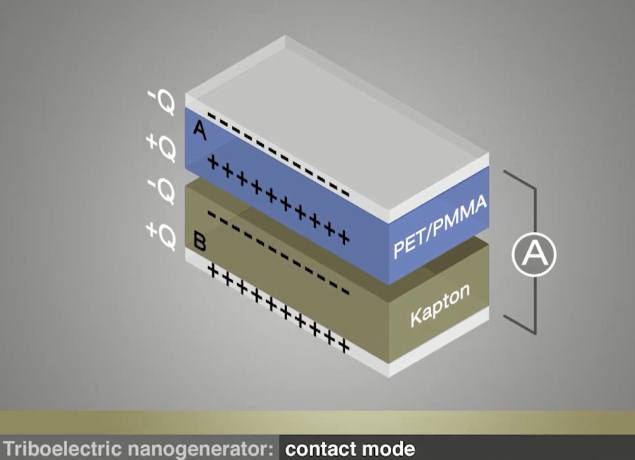- Home
- Mobiles
- Mobiles News
- Triboelectric nanogenerators to power mobiles through everyday motion
Triboelectric nanogenerators to power mobiles through everyday motion

Zhong Lin Wang and his team at the Georgia Institute of Technology worked on a miniature generator based on an energy phenomenon called the piezoelectric effect, which is electricity resulting from pressure.
To the researchers' surprise, the generator produced more power than expected. They investigated what caused the spike and discovered that two polymer surfaces in the device had rubbed together, producing what's called a triboelectric effect.
Building on the discovery, Wang developed the first triboelectric nanogenerator, or "TENG."
He paired two sheets of different materials together - one donates electrons, and the other accepts them. When the sheets touch, electrons flow from one to the other. When the sheets are separated, a voltage develops between them.
They then boosted the power output density by a factor of 100,000, with the output power density reaching 300 watts per square metre.
With one stomp of his foot, Wang claims to light up a sheet with a thousand LED bulbs.
His group has incorporated TENG into shoe insoles, whistles, foot pedals, floor mats, backpacks and ocean buoys for a variety of potential applications.
"These gadgets harness the power of everyday motion from the minute ( think vibrations, rubbing, stepping) to the global and endless (waves)," researchers said.
These movements produce mechanical energy that has been around us all along, but scientists didn't know how to convert it directly to usable power in a sustainable way until now.
The key to the huge leap in output and future improvements is the chemistry.
"Making patterns of nanomaterials on the polymer films' surfaces increases the contact area between the sheets and can make a 1,000-fold difference in the power generated," said Wang.
Wang said his group is now working on commercialising products to recharge cell phones and other mobile devices using TENG.
Down the road, he envisions these nanogenerators can make a far bigger impact on a much larger scale.
The technology could be used to tap into the endless energy of ocean waves, rain drops and the wind all around us - with tiny generators rather than towering turbines - to help feed the world's ever-growing energy demand, he said.
Researchers presented their findings at the National Meeting & Exposition of the American Chemical Society (ACS) in Dallas, US.Catch the latest from the Consumer Electronics Show on Gadgets 360, at our CES 2026 hub.
Related Stories
- Samsung Galaxy Unpacked 2025
- ChatGPT
- Redmi Note 14 Pro+
- iPhone 16
- Apple Vision Pro
- Oneplus 12
- OnePlus Nord CE 3 Lite 5G
- iPhone 13
- Xiaomi 14 Pro
- Oppo Find N3
- Tecno Spark Go (2023)
- Realme V30
- Best Phones Under 25000
- Samsung Galaxy S24 Series
- Cryptocurrency
- iQoo 12
- Samsung Galaxy S24 Ultra
- Giottus
- Samsung Galaxy Z Flip 5
- Apple 'Scary Fast'
- Housefull 5
- GoPro Hero 12 Black Review
- Invincible Season 2
- JioGlass
- HD Ready TV
- Laptop Under 50000
- Smartwatch Under 10000
- Latest Mobile Phones
- Compare Phones
- OPPO Reno 15 Pro Max
- Honor Win RT
- Honor Win
- Xiaomi 17 Ultra Leica Edition
- Xiaomi 17 Ultra
- Huawei Nova 15
- Huawei Nova 15 Pro
- Huawei Nova 15 Ultra
- Asus ProArt P16
- MacBook Pro 14-inch (M5, 2025)
- OPPO Pad Air 5
- Huawei MatePad 11.5 (2026)
- Xiaomi Watch 5
- Huawei Watch 10th Anniversary Edition
- Acerpure Nitro Z Series 100-inch QLED TV
- Samsung 43 Inch LED Ultra HD (4K) Smart TV (UA43UE81AFULXL)
- Asus ROG Ally
- Nintendo Switch Lite
- Haier 1.6 Ton 5 Star Inverter Split AC (HSU19G-MZAID5BN-INV)
- Haier 1.6 Ton 5 Star Inverter Split AC (HSU19G-MZAIM5BN-INV)

















